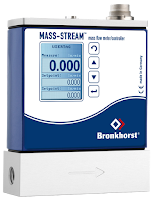Reprinted with permission from Kurz Instruments
 |
| Kurz Thermal Flow Meters for Dry & Wet Gas Applications |
Several steps within the pulp and paper making process create emissions that must be monitored and reported:
- Bark is typically burned as fuel for a boiler.
- Chemicals (green liquor and white liquor) used in the digester to separate the cellulose fibers that become pulp result in emissions containing formaldehyde, methanol, acetaldehyde, and methyl ethyl ketone.
- High temperatures during the washing and screening processes generate exhaust gases.
- Any bleaching process includes chlorine or peroxide that must be vented.
- Fiber particles and chemicals are filtered out and recovered. The recovered material is called “black liquor” and is burned in a recovery boiler to provide additional power for the mill, generating exhaust gases.
- Wastewater generated during the pulp process is diverted to a wastewater treatment facility, where it is treated and recycled before being reused or released.
- Create excessive amounts of pollutant gases
- Create extra soot to coat boiler tubes
- Reduce chemical recovery efficiency
- Cause excess corrosion problems for boiler components
- Reduce the boiler’s steam production
 |
| Simplified Recovery Boiler (click for larger view) |
- The primary air flow system maximizes chemical recovery. Primary air optimizes bed size, shape, and temperature.
- A secondary air flow system is used to maintain complete combustion with dynamic mixing. The secondary air dehydrates the black liquor, and controls bed size, shape, and height.
- A tertiary air flow system is used to prevent the chemical reaction/processes from reaching the upper regions of the boiler and damaging the boiler tubes. This also generates an even temperature profile across the unit.
- The molten waste is recovered and dissolved in water to create the green liquor used in the separation process.
THERMAL FLOW METER APPLICATION OPPORTUNITIES
Specific installations have included flow meters used in the following environments:
- Measuring combustion air to a boiler
- Measuring primary/secondary/tertiary air to a recovery boiler
- Monitoring stack flue gas
- Measuring stack emissions
- Monitoring digester gases and aeration air
- Measuring inlet combustion air to gas turbine generator sets
- Controlling tight fuel-to-air tolerances, such as with natural gas
- Measuring turbine exhaust gases
- Measuring overfire and underfire air
For more information on Kurz Thermal Flow Meters, contact Hile Controls of Alabama by visiting https://hilealabama.com or by calling 800-536-0269.

